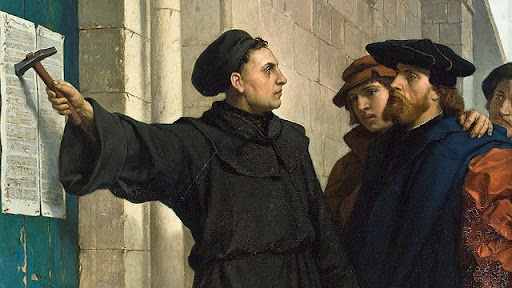Coram Deo is a classical Christian school. We are a Christian school that is recovering the 3 Rs of education–reading, writing, and ‘rithmetic. These tools of learning are critical for building well-rounded individuals. We are also recovering another set of 3 Rs: the Renaissance, the Reformation, and the Revolution. The Renaissance, started in 1300s; the Reformation, started in 1500s; and the Revolution, started in 1700s, all recovered something that had been lost. The Renaissance recovered science, art, and literature from the Middle Ages.

The Reformation recovered truth from error in the established church.

The Revolution, the American revolution that is, recovered individual freedom from the abuses of the English monarchy. The Revolution could have never happened without the Reformation because of the Founders’ dependence upon the Bible and how the constitution is modeled after the covenant in Exodus.

Each of these three R’s has important lessons for Christian students today, both positive and negative. Of particular importance in the month of October is that second R, the Reformation.
In American culture, many children think of the end of October as a time of chocolate candy, ghost costumes, and energetic fun. There is not a problem with sweets or pirate costumes or mid-week fun for Christian families. There is Christian freedom on such matters of adiaphora (neutrality). We’d be richly blessed if we would also remember a matter of great significance that took place on October 31 more than 500 years ago.
On October 31, 1517, a university professor named Martin Luther nailed a sheet to the castle door explaining errors in the church. He listed, in Latin, 95 errors of the church and invited his fellow faculty members to come to a debate the next day where they could discuss these errors. This action is typically considered to be the dawn, or inciting incident, of the Reformation. A group of students took down the papers nailed to the door and went to the press to have them copied and distributed. Within a year, the majority of Germany had read his 95 theses that challenged the established church.
Understanding the heart of the Reformation comes back to Galatians 1:6-8.
Galatians 1:6-8 says, “I am astonished that you are so quickly deserting him who called you in the grace of Christ and are turning to a different gospel— 7 not that there is another one, but there are some who trouble you and want to distort the gospel of Christ. 8 But even if we or an angel from heaven should preach to you a gospel contrary to the one we preached to you, let him be accursed.”
The Gospel of Christ is an announcement of good news. Paul wrote to the Galatians to turn down the volume on the false teachers that were telling the Galatian Christians that they had to add special works to their belief in Christ in order to be saved. Paul’s letter to the Galatians has a mathematical center that it rotates around–it is a clear formula.
Jesus + Nothing = Everything.
Christ alone is the good news for anyone, anywhere who would believe. For tall people, short people, left handed people, right handed people, guitar players, violinists, morning people, night owls, lazy people, ambitious people, kindergartners, grandparents, 6th graders, and on down the list–Christ came with a message of good news to all sinners. But Paul is not the only one who came to Galatia with good news.
Other people snuck in and taught differently and said that circumcision was required for salvation. They taught a different mathematical formula than Paul. They taught,
“Jesus + Works = Everything.”
The false teachers in Galatia did believe in Jesus. They probably thought themselves to be Christians but they did not believe that salvation was through Christ alone. The center of Paul’s message was the cross of Christ. He did not brag about anything but the cross. He wrote in Galatians 6:14,
“But far be it from me to boast except in the cross of our Lord Jesus Christ, by which the world has been crucified to me, and I to the world.”
You cannot understand the Reformation without this emphasis on the cross of Christ and the phrase Christ alone. Paul is consistent in all his letters with the Christ-centered emphasis on the cross as our only hope. In Philippians 2:8, Paul writes,
“And being found in human form, he humbled himself by becoming obedient to the point of death, even death on a cross.”
Christ corrects our corruption by being punished for human sins.
Your works cannot save you because you owe God too much. Only Christ’s blood will satisfy holy God. This is the heart of the Reformation. Paul writes in Colossians 2:14, “by canceling the record of debt that stood against us with its legal demands. This he set aside, nailing it to the cross.” Do not trust in the strength of your personality, or your human beauty, or any of the medals or trophies you have accumulated. The two things you get when you turn from yourself and turn to Christ in faith are forgiveness and righteousness. Jesus + Nothing = Everything. He takes your filth and you get His purity.
In Galatians 1:6-8 Paul is astonished that the Galatians would stop listening to the message of forgiveness and depart for another gospel that is based on works rather than grace. Paul wants to stop those who are troubling the Galatians. In his commentary on this verse, the Reformer Martin Luther wrote,
“Some mad head could stop the gospel going forward prosperously — in one moment, he could overturn what has taken many years to be built.”
In the Reformation, Luther is trying to do exactly what Paul did to the Galatians. Luther goes on,
“The church is so tender and soft a thing and can easily be overthrown with false teaching — men must watch carefully against these fantastical spirits…. bold fellows who have never learned to fear God nor had any taste or feeling of grace.”
I have a dog that barks whenever anyone pulls in our driveway. Daisy wants to protect us so she alerts us to the arrival of a potential intruder. Luther is barking because His Master’s Gospel is being attacked. So what exactly happened on October 31, 1517?

Martin Luther was 8 years old when Christopher Columbus set out to discover America. He lived in a world before planes, trains and automobiles and the printing press was the most advanced technology of his day. He comes after the Renaissance but before the Revolutions in France, America, England, and Russia. He lived in a different world but with humans who had the same problems.
Martin Luther was 34 when he nailed those 95 Latin arguments on the church doors. These served as a bulletin board for the other teachers at the University of Wittenberg where he taught. This was similar to him sending an email to his other professors. The 95 Theses announced at the top of the scroll,
“The Ninety-Five Theses The Disputation on the Power and Efficacy of Indulgences Posted: October 31, 1517 The Eve of All Saints Day Castle Church Wittenberg, Germany. For oral debate on November 1, 1517 Out of love and zeal for truth and the desire to bring it to light, the following theses will be publicly discussed at Wittenberg under the chairmanship of the reverend father, Martin Luther, Master of Arts and Sacred Theology and regularly appointed Lecturer on these subjects at that place. He requests that those who cannot be present to debate orally with us will do so by letter.”
He is inviting his other professors to a debate. He then lists out 95 short sentences making his argument. The first argument says,
“When our Lord and Master Jesus Christ said, “Repent” [Matthew 4:17], he willed the entire life of believers to be one of repentance.”
The heart of the reformation starts with humble repentance, turning from self and turning to God. The seventh argument says,
“They preach only human doctrines who say that as soon as the money clinks into the money chest, the soul flies out of purgatory.”

Here’s the villain in the story of the Reformation, Yohan Tezel.
Tezel was gathering Luther’s students and teaching them that there was not just Heaven and Hell but a place called purgatory. Tezel was teaching that many would have to go to purgatory after death to be purged, or purified, from their sins on earth before they could enter the gates of heaven. But purgatory was not the major issue; the major issue was that Tezel was having people pay to reduce the time that their loved ones sent in purgatory. Tezel would gather 1,000s of Germans in the street and show his skills as a persuasive salesman. He would yell out, “Every time a coin in the coffer rings a soul from purgatory springs.” The people that Luther was trying to teach were being pulled away to a different Gospel. Tezel is saying step right up step right up… the church has a special sale going on today. You or your loved one can buy your way into heaven. When Luther nailed those 95 arguments to a door, he was barking at Yohan Tezel and telling them to get away from the Lord’s sheep.
But here is what classical Christian students cannot miss when it comes to this story. Luther got a classical Christian education, because his father wanted him to be a successful lawyer. After almost being struck by lightning, Luther abandoned his father’s plans for his life and decided to become a monk. Almost 15 years before he nailed the 95 theses to the wall, Luther become an Augustinian monk. At this point, he did not have a clear understanding of the Gospel. Luther knew he had guilt before a holy God but he tried to erase the stain of his guilt with his own works. He would spend hours confessing to priests. He would walk up staircases on his knees saying prayers at every stair believing that his prayers and his kneelings could erase his guilt. Luther is proof to students in classical schools that the liberal arts of grammar, logic and rhetoric do not swing open the doors of heaven. In fact, many think that Luther was still not converted when he nailed the 95 theses to the church door at Wittenberg.
In 1510, 7 years before the 95 Theses, Luther visited Rome which was a supreme act of devotion for an Augustinian monk. When he arrived, he fell to the earth, raised his hands and said, “Hail to thee, holy Rome! Thrice holy for the blood of the martyrs shed here.” Luther thirsted for a unique spiritual experience so he visited the graves of forty-six popes and the cemeteries of 80,000 martyr’s bones. He also visited a location known as the holy stairs which is said to be where Jesus stood on trial before Pontius Pilate.

Luther went up all 28 steps saying an ‘Our Father’ prayer with the hopes that he could release his grandfather, Lindemann Luther, from purgatory. Years later, Luther wrote on his visit to Rome saying,
“Although I was a holy and irreproachable monk, my conscience was full of trouble and anguish.”
Luther was trying to stairstep his way into Heaven not realizing that only Christ had to walk up those steps.
Luther became a believer when he was lecturing on the book of Romans in his university classroom. The verse that changed everything for Luther was Romans 1:17,
“For in it the righteousness of God is revealed from faith for faith as it is written, “The righteous shall live by faith.”
Luther’s big realization was that righteousness comes from God and is a gift of God. It is not an achievement of man. Only holy God can make the sinner righteous. Luther wrote, “For I hated that word righteousness of God.’” Luther believed that the greatest sin anyone committed was that they broke the greatest commandment, to love God. He knew that he did not love God perfectly and he could not deal with guilt. But when Luther realized that righteousness is given to those with faith, his guilt was relieved. He wrote, “when I discovered that, I was born again by the Holy Ghost and the doors of heaven swung open!”
When you think of Luther, you need to know of the 95 Theses in 1517 but also of the Diet (or Assembly of Worms) in 1521. Luther caused quite a disturbance with his protest of the established church. The 95 theses in 1517 was just the start. In 1521 at the Diet of Worms, Luther went past the point of no return in conflict with the authorities of the church. The Holy Roman Emperor Charles V invited Luther to an assembly due to Luther’s criticisms of the church.
Luther was 15 years older than Charles V and thought he was going to attend a debate but he was asked only two questions. He was shown a table of all of the books that he had written and he was asked if they were his books. The church authorities could not believe that one man could write so much in such a short amount of time. The young Luther affirmed that they were indeed his works. The second question was, “Will you recant of these works?” In other words, will you confess that these are in error because they contradict the teaching of the church. In response, Luther asked for one day to contemplate their request.
On the next day, Luther returned to the assembly and was asked to answer the question, “Martin Luther will you recant of your writings?”

Luther replied that he needed to be shown his error based upon what the Bible said. The emperor was infuriated by his response and said, “Will you recant or not? Deal plainly and do not give us a horned response!”
And here is the moment that changed history. Luther responded,
“I will give you a simple answer that is neither horned nor toothed… Unless I am convinced by the testimony of the Scriptures or by clear reason (for I do not trust either in the pope or in the councils alone, since it is well known that they have often erred and contradicted themselves), I am bound by the Scriptures I have quoted, and my conscience is captive to the Word of God.”
Like Isaiah or Jeremiah or Ezekiel, Luther was calling the people of faith back to God. He could not trust in the councils and doctrines of men but only the word of God. He was not willing to recant but his conscience was bound to the Word of God.
Like Paul in Galatians 1:6-8, Luther affirms that there is no other Gospel on which we stand for all eternity. There is no staircase that we can climb into God’s presence. There is no payment a man can make to get into heaven. The gospel was at issue and he was not willing to budge. Luther stood in the Gospel of Jesus Christ. This was a central issue because heaven and hell are in the balance. Luther wrote,
“The doctrine of justification is not simply one doctrine among others but the basic and chief article of faith with which the church stands or falls, and on which its entire doctrine depends.”
Christians today must also bark when this good news is replaced with counterfeits.
500 years later, we live after the Renaissance, the Reformation, and the Revolution. We must be willing to acknowledge the good and the bad that resulted from Luther’s heroism that started on October 31, 1517. Whenever we study history, we know that only one man is perfect, Jesus Christ. With Luther, we should take the best and leave the rest. At many times, Luther used harsh language that we should not imitate. Today, those who stood with Luther on the doctrine of justification are called Protestants and those who stood with the established church are called Catholics. This distinction did not exist in 1500 but in 1600, the people of faith were divided. This was not Luther’s initial goal.
Luther’s goal was recovery, renewal, and reformation, not rupture and division. He was seeking to call the church back, not divide into the many denominations that we have today. Many in the established church at the time were not willing to repent of the error of indulgences. Luther had a classical education but his life really changed when he understood the Gospel. His real impact came when he realized that the work is done and it was done by Christ. My hope for every student at Coram Deo Academy is that they would do business with God and receive by faith the forgiveness and righteousness that is their possession in Christ. Coram Deo means that we do not keep God at a distance and relate to Him according to our performance. It means that we come near to Him through the grace of Christ. Draw near to God. Christ alone is our only hope. Soli Deo Gloria.
Resources
- History of Western Philosophy and Theology by Frame
- Turning Points: Decisive Moments in the History of Christianity by Noll
- History of Theology by Olson and English
- Commentary on Galatians by Luther
- Theology of the Reformers by George Grant




